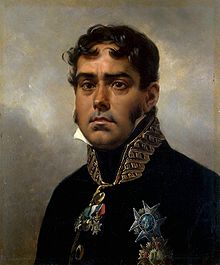
Back بابلو موريلو Arabic بابلو موريلو ARZ Pablo Morillo Catalan Pablo Morillo German Pablo Morillo Esperanto Pablo Morillo Spanish Pablo Morillo French Pablo Morillo Galician Pablo Morillo Italian Pablo Morillo Portuguese
This article has multiple issues. Please help improve it or discuss these issues on the talk page. (Learn how and when to remove these messages)
|
Pablo Morillo y Morillo | |
|---|---|
 | |
| Captain General of Venezuela | |
| In office 1815–1816 | |
| Monarch | Ferdinand VII |
| Preceded by | Juan Manuel Cajigal |
| Succeeded by | Salvador de Moxó |
| In office 1819–1820 | |
| Preceded by | Juan Bautista Pardo |
| Succeeded by | Miguel de la Torre |
| Personal details | |
| Born | 5 May 1775 Fuentesecas, Spain |
| Died | 27 July 1837 (aged 62) Barèges, France |
| Signature |  |
| Military service | |
| Allegiance | Kingdom of Spain |
| Branch/service | Spanish Navy (1792-1808) Spanish Army from 1808 |
| Rank | Lieutenant General |
| Commands | Ejército Expedicionario de Tierra Firme |
| Battles/wars | |
Pablo Morillo y Morillo, Count of Cartagena and Marquess of La Puerta, a.k.a. El Pacificador (The Peace Maker) (5 May 1775 – 27 July 1837) was a Spanish military officer who fought in the Napoleonic Wars and in the Spanish American Independence Wars. He fought against French forces in the Peninsular War, where he gained fame and rose to the rank of Field Marshall for his valiant actions.[1] After the restoration of the Spanish Monarchy, Morillo, then regarded as one of the Spanish Army's most prestigious officers,[2] was named by King Ferdinand VIII as commander-in-chief of the Expeditionary Army of Costa Firme with the goal to restore absolutism in Spain's possessions in the Americas.[3]
Born to a peasant family in Fuentesecas, Spain, at the age of 16 he joined the Spanish Navy as part of the Spanish Marine Infantry, where fought in the Battle of Cape St. Vincent and the Battle of Trafalgar; both times he would be taken prisoner. After the outbreak of the Peninsular War, Morillo left the Spanish Navy and joined the Spanish Army and fought at the Battle of Bailen under the command of General Castaños; he would also be present at the Battle of Vitoria. He rose through the ranks quickly during the war. His actions at the Battle of Puente Sanpayo won him fame, as he commanded an army that defeated Marshal Ney and forced the French army to evacuate Galicia.[2]
After the end of the war, in 1814, Morillo was named Captain General of Venezuela and given command of an Expeditionary Army to defeat the rebellions in New Granada and Venezuela. This expeditionary force of 60 ships and 10,000 men left Spain in early 1815, arriving in Venezuela in the spring of 1815. Morillo led a successful campaign to Reconquest New Granada. His victory at the Siege of Cartagena earned him the title of Count of Cartagena. He successfully reconquered New Granada in 1816 and ordered the execution of various independence leaders as well as the confiscation of their assets.
In 1817, he returned to Venezuela, where Simon Bolivar had begun a new campaign to liberate Venezuela from Spanish rule. He fought Bolivar to a stalemate, then he managed to best him at the Third Battle of La Puerta in 1818, where he was wounded and successfully defended the capital, Caracas, from Boilvar's forces. This earned him the title of Marquess of La Puerta. After the loss of New Granada in 1819, the war shifted, and in 1820 Morillo signed an armistice with Bolivar and later also signed the treaty on "War Regularization." After repeated requests for retirement, Morillo was finally given royal approval and returned to Spain in 1821.[1] After his service in South America he was appointed Captain General of New Castille in May 1821, a position from which he resigned the following year. In 1832 he was appointed captain general of Galicia, a position he left for health reasons in 1835. He died in the French city of Baregés, where he had gone to take medicinal baths, on July 27, 1837.[2]
- ^ a b Cite error: The named reference
:1was invoked but never defined (see the help page). - ^ a b c "Pablo Morillo y Morillo | Real Academia de la Historia". dbe.rah.es. Retrieved 2024-02-18.
- ^ Echeverri, Marcela; Soriano, Cristina (2023), Soriano, Cristina; Echeverri, Marcela (eds.), "Introduction: Rethinking Latin American Independence in the Twenty-First Century", The Cambridge Companion to Latin American Independence, Cambridge University Press, pp. 11–12, ISBN 978-1-108-49227-0